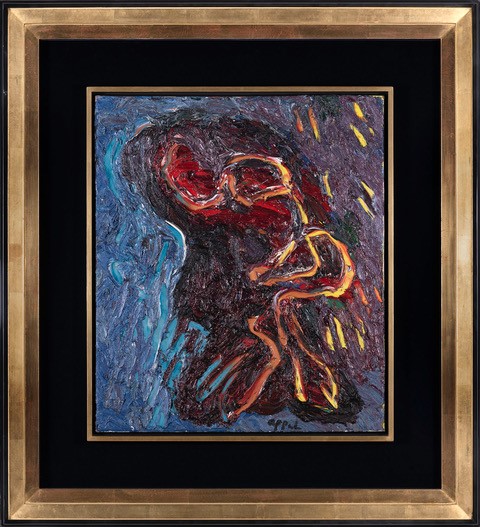Karel Appel
(NL)
Born: Christiaan Karel Appel, 1921. Died: 3 May 2006.
Karel Appel was Dutch painter, sculptor, and poet. He started painting at the age of fourteen and studied at the Rijksakademie in Amsterdam in the 1940s. He was one of the founders of the avant-garde movement CoBrA in 1948. He was also an avid sculptor and has had works featured in MoMA and other museums worldwide.
From 1940 to 1943, during the German occupation, Appel studied at the Rijksakademie van Beeldende Kunsten in Amsterdam, and it was there he met the young painter Corneille and, some years later, Constant; they became close friends for years. His parents opposed his choice to become an artist, leading him to leave home; this was also necessary because he needed to hide from the German police so that he would not be picked up and sent to Germany to work in the weapons industry.
In 1948 Appel joined CoBrA (coined by the Belgian poet Christian Dotremont from the initials of the members’ home countries’ capital cities: Copenhagen, Brussels, Amsterdam) together with the Dutch artists Corneille, Constant, and Jan Nieuwenhuys (see also Aart Kemink). The new art of the CoBrA group was not popular in the Netherlands, but it found a warm and broad welcome in Denmark. By 1939, Danish artists had already started to make spontaneous art and one of their sources of inspiration was Danish and Nordic mythology. It was also in Denmark that the CoBrA artists started cooperating by collectively painting the insides of houses, which encouraged and intensified the exchange of the typical ‘childish’ and spontaneous picture language used by the CoBrA group. Appel used this very intensively; his 1949 fresco ‘Questioning Children’ in Amsterdam City Hall caused controversy and was covered up for ten years.
As a result of this controversy and other negative Dutch reactions to CoBrA, Appel moved to Paris in 1950 and developed his international reputation by travelling to Mexico, the USA, Yugoslavia, and Brazil. He also lived in New York City and Florence. His first American gallery exhibition took place in 1954 at the Martha Jackson Gallery. The following year his painting Child and Beast II (1951) was included in the influential exhibition, The New Decade at the Museum of Modern Art which featured the work of twenty-two European painters and sculptors including newcomers like Francis Bacon, Jean Dubuffet, and Pierre Soulages. He is particularly noted for his mural work. After 1990 he became much more popular in the Netherlands; he had several big shows in Amsterdam and Bruxelles, organized by director Rudy Fuchs. Also, the CoBrA-museum in Amstelveen organized several shows featuring his work. He became the most famous Dutch CoBrA artist.


